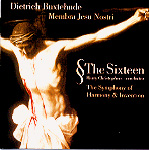The producers of this recording have tried to capture the inherent intimacy of these “meditative” cantatas in an acoustic that doesn’t always cooperate. The various solo voices are close and very clear, the orchestra by itself is slightly farther away but perfectly balanced, and the chorus enters and departs from a distant, very resonant space. Thus, the perspective is not uniformly focused, leaving a listener with a sense of aural disorientation. Which is not to say that there aren’t some really lovely sounds throughout this rather unusual program–Buxtehude’s settings of texts from a medieval poem devoted to the rather grim subject of contemplating various parts of Christ’s crucified body.
The singing from soloists Carolyn Sampson, Libby Crabtree, Robin Blaze, James Gilchrist, and Simon Birchall is uniformly fine, notable for its text-sensitive inflection. The famed Sixteen Choir lives up to its long-standing reputation (hampered only by the above-mentioned acoustical restrictions), and the orchestra of viols, chamber organ, theorbo, cello, and two violins is first rate. The music, in its harmonic simplicity and overtly expressive, emotionally involving devices, especially in its melodies, seems to owe much to earlier Italian madrigal styles–and Buxtehude obviously derived sufficient inspiration from these Latin texts, where his concern apparently was not writing “beautiful” music but rather highly affective interpretations. Consequently, although there’s nothing particularly challenging vocally–and ultimately nothing terribly compelling musically–there’s much for the singers to work with in dramatic terms.
Each self-contained cantata opens with an instrumental “sonata” and proceeds through a series of five subsequent movements, most less than two minutes long and written for various combinations of solo singer, small ensemble of soloists, or choir. Buxtehude arranges these movements so that one flows easily into the next, but usually with a change of vocal scoring, meter, and/or key. Unsurprisingly, the most moving cantata is No. 6, the one that concerns the heart (Ad cor), after which comes the final Ad faciem (To the face) where some of Buxtehude’s more tender passages give way to a lively Amen. Although we often hear Buxtehude’s name mentioned alongside that of J.S. Bach, this music reminds us of how far removed these two composers were in nearly every respect–not only by years and physical distance, but in the relative sophistication, refinement, and scope of even shorter works such as these. Buxtehude certainly must have been a great organist–but his vocal/choral compositions remain mostly a curiosity for Baroque enthusiasts.
































